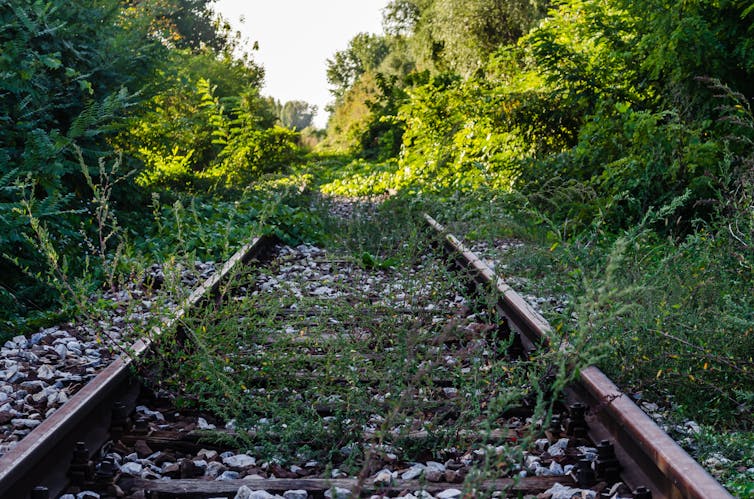Transport emissions have doubled in 40 years – expand railways to get them on track

In the quest to cut carbon out of civilisation, the future of transport is key. Emissions from the sector have doubled in the past 40 years and continue to rise. Our travel habits are now responsible for one in four of the planet-warming molecules of carbon dioxide in our atmosphere.
While the transition to electric vehicles will kickstart progress, even a rapid shift will not on its own bring the sector close enough to carbon neutrality to limit warming below dangerous levels. We’ll also need radical and rapid reductions in road traffic – facilitated by a shift to walking, cycling and public transport.
After decades of stalled progress, researchers and policymakers are grappling with how to make that happen – and railways could be an important part of the answer.
They are highly efficient users of both land and energy – a train can carry several hundred people without having to lift a heavy machine into the air, and moves with much less friction than faced by tyres on roads. Electric trains are particularly energy efficient, as they don’t have to carry diesel fuel or diesel engines, so are lighter and require less maintenance.
Because of this, electrified rail travel uses seven times less CO₂ than road travel and 20 times less than air travel. Investment in high-speed rail lines in Europe, for example, has transferred significant traffic from roads and flight paths, resulting in a 60% reduction in carbon emissions on the affected routes.

The carbon-saving potential of rail is even greater for freight. Heavy goods vehicles contribute substantially to transport emissions – but because of their weight, battery technology is not yet an option to reduce this burden. Rail freight produces 76% less carbon emissions than an equivalent journey by heavy goods vehicle.
And as the electricity grid and train infrastructure transition further to renewable power, carbon savings for both passenger and freight rail services have the potential to get even bigger.
Ramping up rail
Of course, a big switch to rail means a great deal of new and costly infrastructure. Capacity on existing lines would need to be boosted, and new lines, stations, and logistics terminals added. But these efforts don’t have to all be from scratch. Many disused lines could be reopened – there are proposals for 224 line reopenings in the UK alone.Some increases in rail capacity do not require new lines at all, so are less expensive. For example, making trains longer, upgrading signalling, adding passing loops, or upgrading junctions can all boost capacity on existing lines.
But even new lines and terminals can be a cost-effective way of reducing carbon emissions, so long as they are planned carefully. For example, emissions savings from the UK’s controversial HS2 project could vary hugely depending on the energy sources used for rail and road, how the capacity released on parallel existing lines is used and, perhaps most importantly, the siting of and development around stations.
It’s particularly important to promote housing developments around railway stations that decrease dependence on cars. Railway stations should also have good transport interchanges, with high-quality connecting local public transport services and good cycling and walking routes that enable travellers to get from their starting point or to their destination without having to drive. Integrated timetabling is crucial to make this a success, so that railways are part of seamless door-to-door travel.

Properly planned development like this not only reduces emissions, but also limits the conversion of environmentally fragile land to low-density housing development and creates healthier and less isolated communities.
Laying the tracks
Pricing, taxation and subsidy policies also need to support rail growth. There is good evidence that rail freight is more widely used in countries where heavy goods vehicles pay road tolls. Aviation ticket taxes can also drive more people to travel by rail. In contrast, campaigners have argued that the UK governmnent’s freeze on fuel taxation, combined with a policy of increasing rail fares over time by inflation or above, has had the opposite effect, driving increased car use.At a more local level, the availability and cost of car parking also influences demand for car travel over rail travel. For example, reduced car parking and increased charges in the city centre of Birmingham, England, coupled with improved rail services, have helped rail overtake car as the preferred way to commute into the city.
The city is now considering following nearby Nottingham’s introduction of a levy on private non-residential parking spaces at workplaces. In Nottingham this levy contributed to the cost of two new light rail lines and new bus services and as a result the city has the highest public transport mode share in the UK outside of London.
Of course, above all, governments need to put their money where their mouth is for rail use to grow. Some countries already are – the German transport minister recently announced a US$86 billion investment in its rail network to double the number of passengers by 2030, while Ireland has increased rail investment by 40%. If other countries follow suit, the coming decades could finally put the trajectory of the transport sector back on track.

Click here to subscribe to our climate action newsletter. Climate change is inevitable. Our response to it isn’t.
Stephen Joseph, Visiting Professor, Smart Mobility Research Unit, University of Hertfordshire
This article is republished from The Conversation under a Creative Commons license. Read the original article.